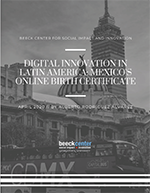How Digital Teams Enable Government Innovation: Case Studies from Latin America
April 20, 2020 | By Alberto Rodrìguez Álvarez and Margarita Arguello
Have you ever needed a copy of your birth certificate, but realized it was stuck in a box hundreds of miles away? Or have you forgotten your wallet at home, only to need your ID for something? These are common problems around the world, and as digital technology is improving, governments are setting innovation hubs to develop groundbreaking solutions to broaden their reach and streamline the delivery of citizen services.
From digitizing medical records to creating entire government portals, public sector technologists are continuously working to incorporate data and design into their operations. They are applying agile methods learned from the tech industry to deliver better services and using human-centered design techniques to transform programs and services. And they are doing this all over the world. Over the past several months, we conducted in-depth research in our home region of Latin America to better understand and document two case studies showing digital government transformation in action: digitizing driver’s licenses in Argentina and digitizing birth certificates in Mexico. These efforts show that other nations are ahead of the United States, and demonstrate that innovative solutions are available from a variety of sources.
One of the co-authors discusses Argentina’s Digital Drivers License during her 2019 Capstone Presentation
Our case studies were conducted as part of the Beeck Center’s Digital Service Collaborative, a project in partnership with The Rockefeller Foundation, and describe both the political transformations that accompany new digital services, as well as the services themselves.
In both case studies, while the design and execution of the specific digital services is the focus of the reports, we also describe the broader digital transformation strategies that were needed for these national governments to take major digitization efforts to two services that touch most, if not all, residents in a society.

Argentina and Mexico are two of many countries that have begun national digital transformation efforts and enabling these innovations has required diverse strategies. Some countries started by embedding small teams into key offices with high-level political support, as is seen with the Government Digital Service (GDS) in the UK (part of the Prime Minister’s Cabinet Office), or the U.S. Digital Service team embedded in the White House. These teams have successfully deployed digital service solutions with both national and local governments copying their models.
We have also seen councils and committees formed across national governments with digital mandates, like in Estonia and Finland, who jointly launched the first international data exchange between commercial business registers and are renowned for their digital government efforts.
In Latin America, there is a middle ground. Countries have created ad-hoc ministries and agencies with broad directives to drive digital transformation efforts. Uruguay’s AGESIC and Brazil’s Secretariat of Digital Government are great examples of teams that are implementing national digital systems like digital identification and digital government dashboards. Latin America is also at the forefront of international cooperation among digital governments, with the Digital Government Network of Latin America convening annually for digital ministries to share best practices.

Despite these successes, in order to have successful results, governments everywhere need to overcome internal barriers to innovation such as outdated practices, restrictive regulatory frameworks, and resistance to change by public servants and decision makers. It is not uncommon to see failed deployment of digital technologies because governments have not undertaken the reforms and negotiations needed to introduce tools that are already standard in other sectors. Public innovation is not only achieved by using new technologies, but by understanding the particular obstacles that every political ecosystem must overcome to enable transformational change.
Overcoming political barriers should be as important a priority as any final innovation product; since it provides a sort of multiplier effect. When government innovation hubs succeed in this, they transform the underlying legal and political frameworks of agencies and offices and open the door to further digital services. These teams set rules, standards, and even interoperability schemas along their process, which then create roadmaps for future innovation everywhere.
Alberto Rodrìguez Álvarez is a Beeck Center Student Analyst currently pursuing a Masters in Public Policy at Georgetown University. Follow him on Twitter at @arodalv
Margarita Arguello is a Beeck Center Student Analyst currently pursuing a Masters in Public Policy at Georgetown University.